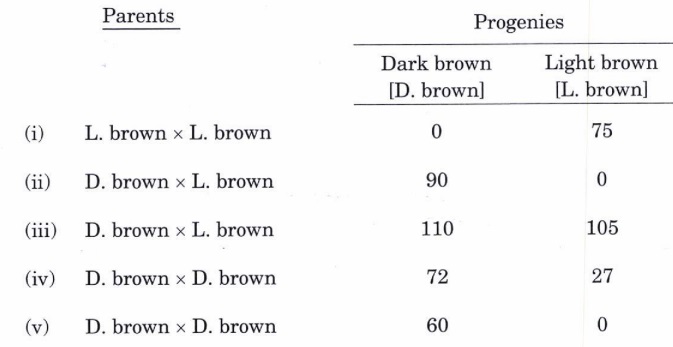
(Download) CS (MAIN) EXAM:2019 BOTANY (Paper 2)
-
Exam Name: CS (MAIN) EXAM:2019 BOTANY (Paper II)
-
Marks: 250
-
Time Allowed : Three Hours
SECTION ‘A’
Q1. Answer the following questions: 10x5=50 marks
(a)“DNA fingerprinting is important in any plant breeding programme.” Justify the statement with suitable examples. 10 marks
(b) Citing example, discuss briefly the process of cytoplasmic inheritance and the genes involved.10 Marks
(c) Explain the mechanism of cell signalling and the role of cell receptors in regulating this process. 10 marks
(d) How does silencing of the genes occur in eukaryotic genome and what are the implications of gene silencing ? 10 marks
(e) Explain, with required diagrams, the chemical structure and function of primary cell wall and plasma membrane.10 marks
Q2.(a) Dark brown seed coat colour in Phaseolus is dominant over light brown colour. The following progenies were produced from the parents with known phenotypes but unknown genotypes in different experiments. 20 marks

Mention the genotype of each parent in five experiments by using the letter B for dark brown and b for light brown.
(b) Discuss the role of Histone in regulating chromatin structure with special emphasis on Histone N-terminal tails as well as nucleosome assembly. 20 marks
(c) Describe the process of DNA replication in eukaryotic organisms with required diagrams, mentioning the role of enzymes in the different steps involved. Comment on the dynamics of replication fork in eukaryotes. 15+5=20 marks
Q3.(a) Discuss briefly the general principles of cellular adhesion. Give a note on identification and characterization of adhesion receptors. 20 marks
(b) Describe sequentially the steps of T-DNA transfer process from Agrobacterium cell to plant nuclear genome. Write a brief note on achievements of gene transfer technology' in crop improvement .20 Marks
(ii) Enumerate the different causes of heterosis. 10 marks
(c) Explain the role of transcription factors associated with transcription initiation, elongation and termination. How does Histone modification regulate chromatin accessibility ?8+2= 10 marks
Q4.(a) Describe the cellular structure and functions of Ribosome and Peroxisome. 10 marks
(b) Discuss two DNA sequencing methods with suitable illustrations. Name two fully sequenced eukaryotic genomes with their sizes. 20 marks
(c) Write explanatory notes on the following: 20 marks
- Polygenic Inheritance
- Sex-linked Inheritance
SECTION 'B'
5. Describe the following in about 150 words each:
Q5. Explain each of the following:
(a) Illustrate the difference between C4 and CAM pathways, giving suitable examples. Write a brief note on their importance. 10 marks
(b) Name at least two plants known to be “plant indicators' and explain their importance in relation to soil quality evaluation. 10 marks
(c) Illustrate with example the importance of energy transfer and energy conservation for plant growth and development. 10 marks
(d) Explain with example the impact of Intellectual Property Rights (IPR) and its global relevance with emphasis on Indian scenario. 10 marks
(e) Discuss the processes of mineral nutrition and mineral deficiencies in dry land areas. 10 marks
Q6. Write explanatory notes with examples on the following:
(a) (i) Difference between aerobic and anaerobic respiration as well as fermentation processes.
(ii) Photorespiration
(iii) Chemo-osmotic theory and ATP synthesis
(b) (i) Restriction endonuclease
(ii) Role of glyoxysomes in conversion of fats into simpler molecules
(iii) Name specific physiological responses on the basis of which IAA, GA, and Kinetin can be identified.
(c) (i) Explain and justify with examples that recycling plays an important role in solid waste management.
(ii) "In the present scenario, Global Warming and Climate Change are amongst the greatest threats for human society.” Justify the statement with examples
Q7. (a) What are the molecular basis and possible manipulations which may help fruit ripening? 15 marks
(b) Illustrate your answer with suitable example, the mechanism by which movement of ions takes place across the cell membrane. 15 marks
(c) Explain with examples, in what way ecosystems and conservation help in the formation of a developed biosphere.20 marks
Q8. (a) Discuss the concept and dynamics of a plant community. Illustrate with suitable examples. 20 marks
(b) Explain the relevance and importance of the following:15 marks
(i) Protected area network
(ii) Invasive species
(iii) Approaches for 'Environmental Impact Assessment
(c) Explain the approaches of Stress physiology in relation to salinity and metal stresses. Support your answer with examples.20 marks